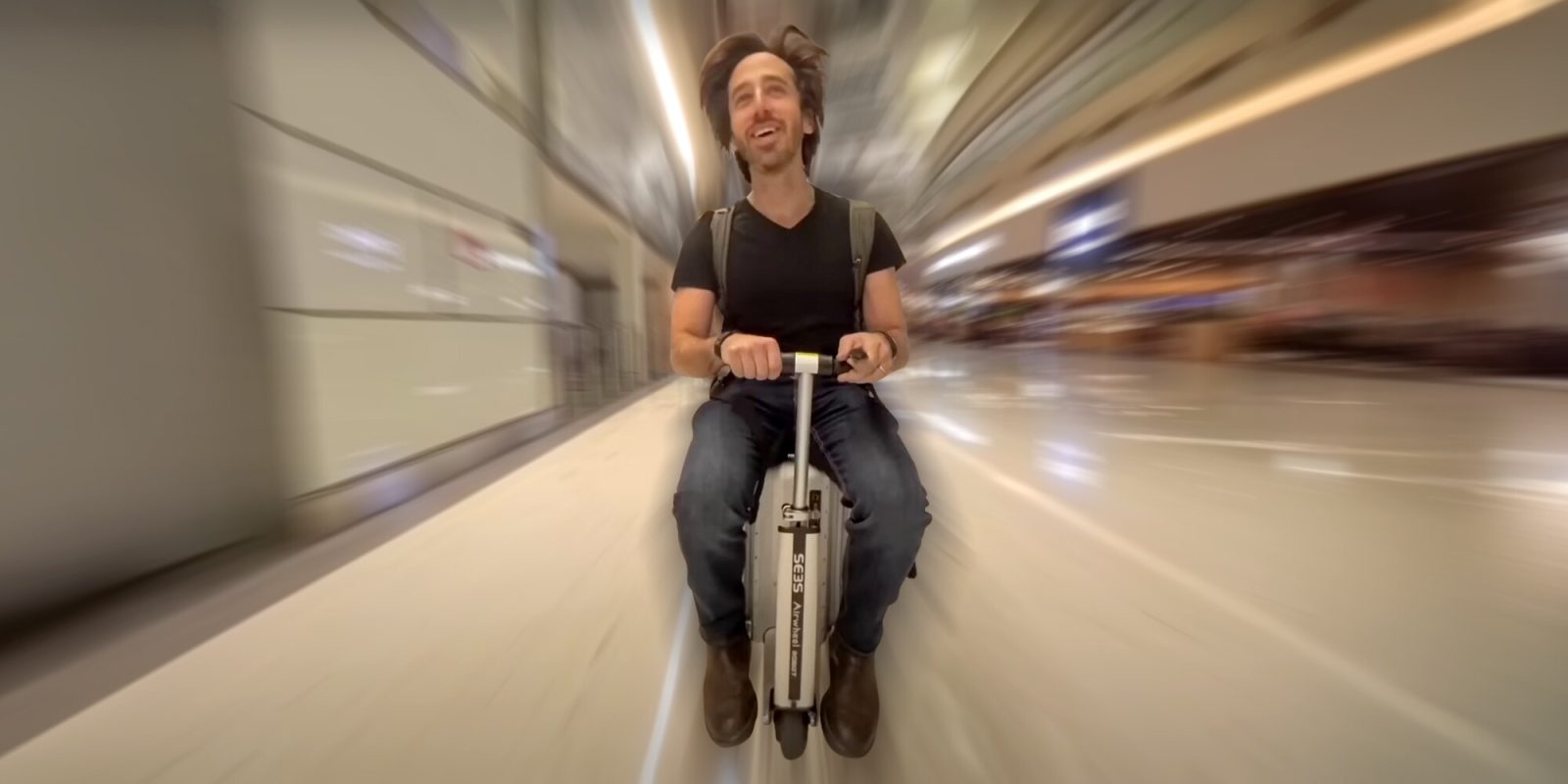
I was recently in China on yet another trip to tour the factories and showrooms of several leading micromobility companies, and I’ll have more to share with you on that trip soon. But first, while I was getting ready to fly out of the Shanghai airport, I stumbled upon the coolest little motorized carry-on suitcase that functions like a seated electric scooter. I ended up buying it on the spot.
Here’s what happened next when I tried to take it 8,000 km (5,000 miles) home.
This time it’s for real
This is the real deal – I actually bought and tested this thing, which I can prove with my hilarious testing video filmed in three different international airports. I highly recommend it, if you’ve got a couple minutes to burn.
So basically, you should know that this is not part of my long-running Awesomely Weird Alibaba Electric Vehicle of the Week series, where I (lovingly) poke fun at some of the odd and awesome EVs found on China’s largest shopping site from the safety on my computer screen. I did happen to feature a motorized suitcase in my last post in the Alibaba series, inspired by the fact that I knew I’d be sharing this review with you all soon. And finally, here we are!
I’ve seen these motorized suitcases floating around the interwebs for some time, but they’ve always been frustratingly expensive. For more than the price of a great e-bike, you can buy one of these motorized suitcase scooters. Since I wasn’t about to drop nearly $900 on a contraption like this, I figured I’d never have the pleasure of experiencing one.
That was until I walked past a shop selling them in the Shanghai airport. I was able to snag it for just 3,000 RMB, or the equivalent of around US $411. It’s still a dumb price, but it’s over half off the going rate in the west.


How does a motorized suitcase scooter work?
This thing is actually a decent rolling suitcase to begin with. It has 26L of storage, large rear rolling wheels, and a solid telescoping handle so you can roll it around like a normal trolley bag.
But when you push the expansion toggle switch the rear, the scooter’s frame extends out of the bottom and you can telescope up the handlebars to turn it into a functional scooter. A little pad tucked under the carry handle serves as a diminutive seat, and the right thumb lever on the handlebars is pressed to activate the electric motor in the single front wheel. The left thumb lever is the brake (just electric motor braking, no physical brakes), and you can engage reverse by holding both thumb levers simultaneously.
For something designed to do two things at once, which is normally a recipe for mediocrity at both, it actually surprised me in a good way. The suitcase works fine, even if you lose some of its interior storage that is taken up by the scooter’s frame. You also get the nice feature of the suitcase’s battery functioning like a USB power bank, so that’s another cool feature. And as a scooter, it’s decently comfortable, though a bit cramped.
I will say that the zipper on the bag feels a bit cheap and seems to me like it could be the first thing that will eventually break, rendering the bag useless for carrying anything, but until then it works pretty well at its job.
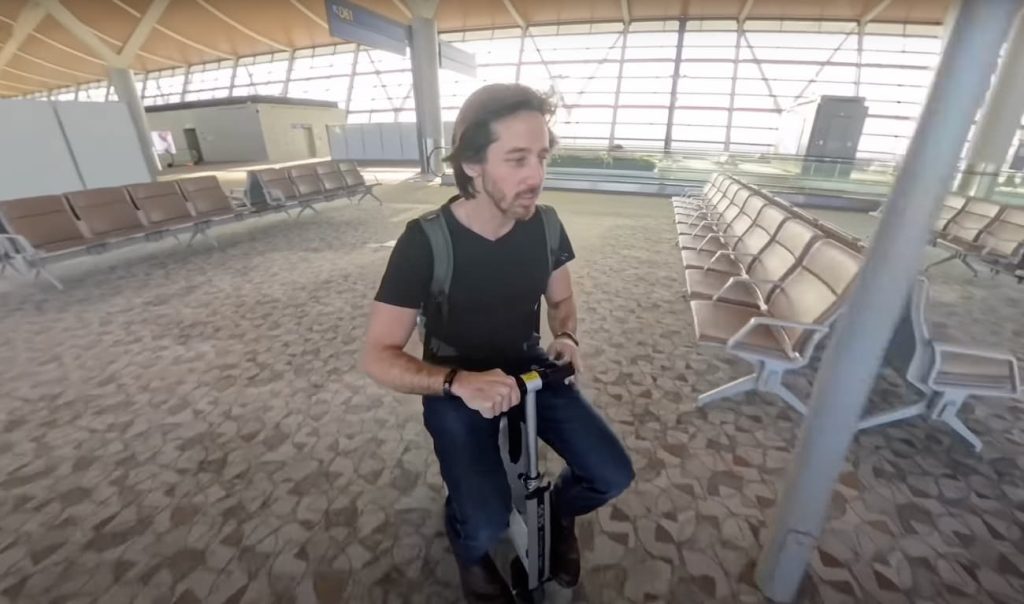
How good can a motorized suitcase scooter be?
This specific suitcase is the Airwheel SE3S, and the marketing says it can get up to 13 km/h (8 mph). My journey home from China started in Shanghai, where for the first couple kilometers of scooting, I didn’t realize I only had the suitcase in the middle power mode and not its highest setting.
I still had a lot of fun scooting around the airport and I was even going faster than folks walking on the moving walkways, so the middle gear was still plenty fast.
But after arriving at my connection in Abu Dhabi, I downloaded the smartphone app and discovered that I could fully unlock the speed. At that point, I was using every single one of those 300 watts available in the front motor to rocket me up to 13 km/h. In fact, I was going so fast that when I would hit the metal expansion joints in the airport floor, the little 92 Wh battery would bounce up off of its connector and I’d momentarily lose power. I could reach behind me and push the battery back down, then all was good again. And it really only happened in the highest power mode, which is when I’d hit any bumps with the most force.
But keep in mind that that if you hit any bumps at full speed, you might have to deal with momentary power interruptions. Not ideal, but still better than the trolley bag that I’d have to pull instead of this one pulling me!
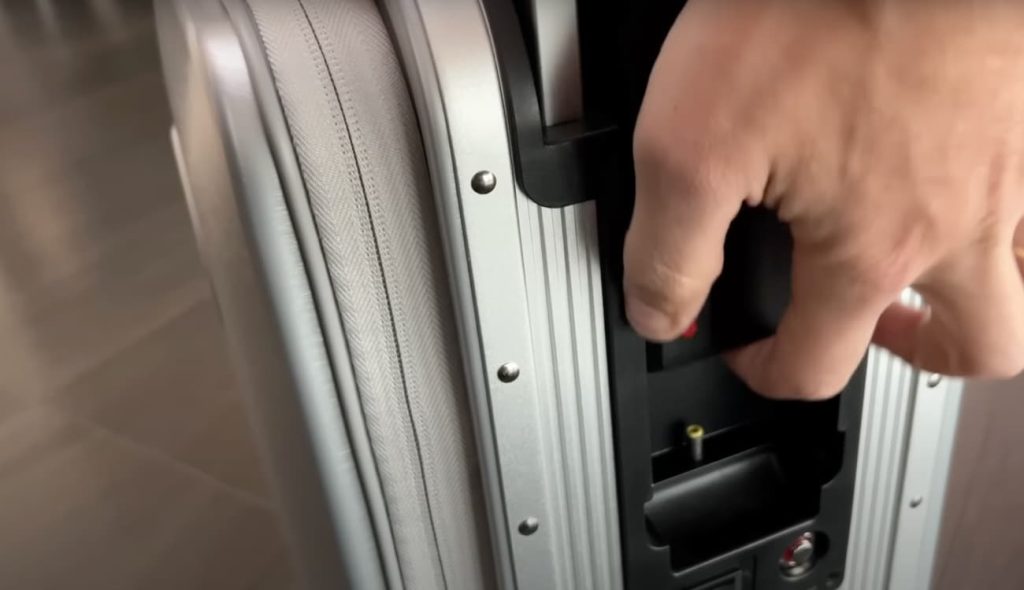
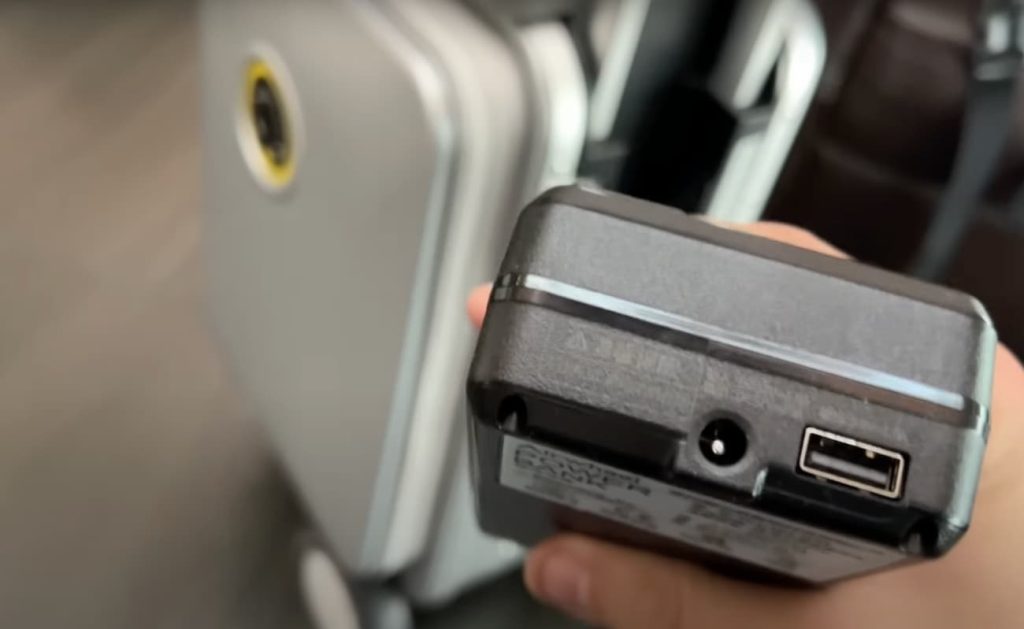
To be frank, I’m actually amazed that the thing was pulling 300W through that little barrel connector (easier to see in the video).
But it never felt like anything was heating up too much, so I guess they have spec’d some sufficiently capable copper and enough heat dissipation on either side to make it work. Or it’s not really pulling 300W, which would make sense since how much power does one really need to go 13 km/h on a flat airport floor?
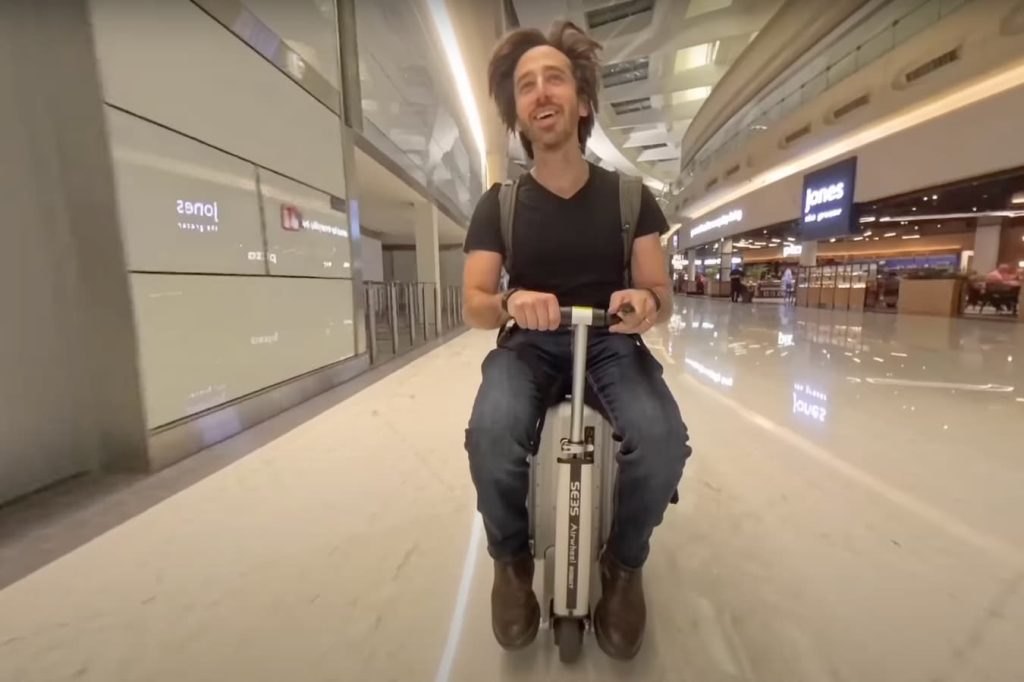
I also found other features that were available in the app, such as changing the color of the LED lighting in the scooter and controlling the suitcase remotely from my phone. The latter was pretty funny to test out – imagine pushing a button on your phone and watching your suitcase drive away.
Both seem like novelties, so I didn’t really mess with those features very much in practice.
I could see in the app that by this point I had scooted around 3 km (nearly 2 miles) in the Shanghai and Abu Dhabi airports, which was a weird statistic to have for a suitcase, but I was pretty proud of it.
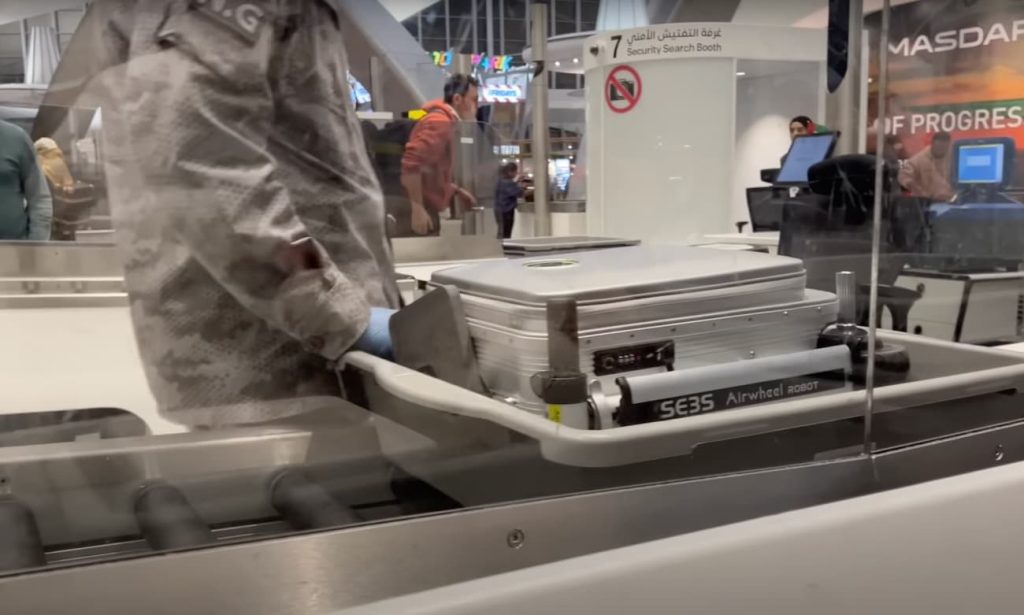
Can you legally fly with an electric motorized suitcase?
I never once had an issue with the bag, though it did get pulled off to the side for additional screening in Abu Dhabi. The battery had already been removed, but it went it got pulled off into the lane of shame after the X-ray scan anyway.
That when a big UAE dude in military fatigues carried my scootcase over to the inspection counter, took one look at the computer screen with its scan on it, and told me it was good to go. No extra inspection. I popped the battery back in and rode away, as one does in these situations.
With a 92 Wh battery that neatly fits under the 100 Wh limit used by most airlines for lithium-ion batteries in carry-on bags, there’s really nothing else that would disqualify this as a legal carry-on bag in most cases. There are some airlines that have specifically banned hoverboards and other rideables, so you may want to double check, but I had no issue in three international airports.

But the journey wasn’t over yet
The final leg of my journey was a flight from Abu Dhabi to Tel Aviv, and the Airwheel suitcase performed admirably yet again. It fit just fine in the overhead storage compartment and was ready to rock n’ roll as soon as I was off the plane.
In fact, just because Ben Gurion Airport was my final stop, that didn’t mean I was done scooting. I took the train from the airport to a stop around 2 km (1.2 miles) from my apartment, then tried to ride my suitcase the rest of the way home. I probably could have made it since the battery is rated for around 8 km (5 mi) per charge, but it just felt pretty darn slow. So I put it on a Lime scooter and rode the pair of us most of the rest of the way at a much peppier 25 km/h (15 mph).
Close to home, I switched back to my suitcase so I could ride the last few hundred meters in style. And to finish strong, I was able to ride it right up the handicap accessible ramp into the lobby of my building, into the elevator, back out of the elevator (in reverse, mind you), and right up to my apartment door.
I had successfully ridden the suitcase from a Shanghai airport shop to my living room, albeit with a few planes, a train, and a Lime scooter in between.

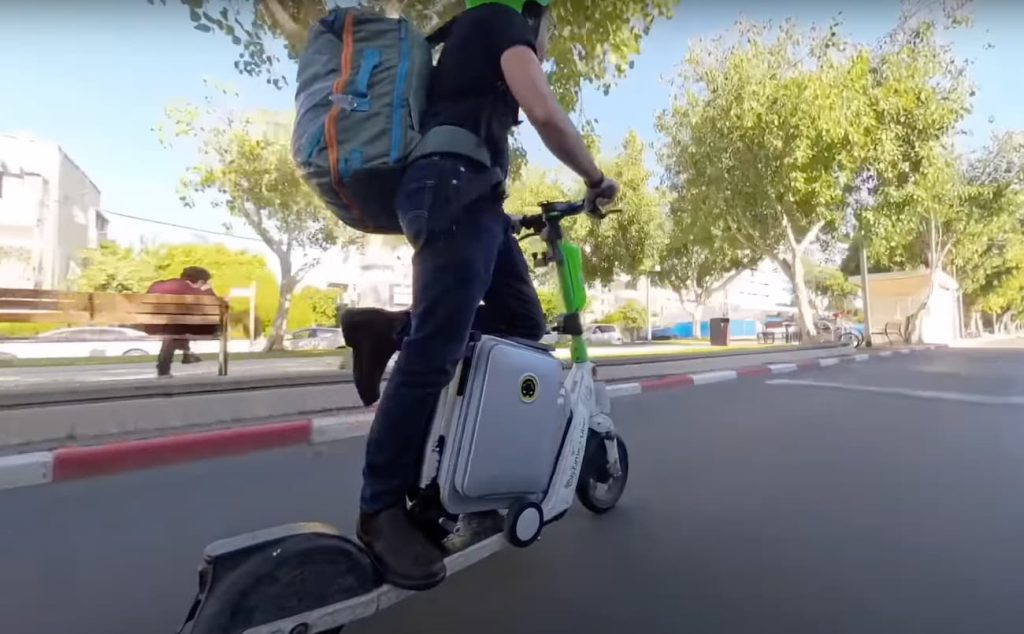
What’s the verdict?
Top comment by Grant
Haha, Micah great article! I really enjoy reading your adventures.
At just over US $400, I can barely justify this thing, at least for me. Yes, it actually worked great and was super fun, but I’m not exactly the target market.
For someone who has trouble walking long distances in an airport, this would definitely be a better way to get around.
But at the Amazon price of nearly US $900, it’s hard for me to call this a “buy”. Don’t get me wrong, I had a blast on it and don’t regret it, even if I’m probably going to try to sell it used for close to what I bought it for and recoup my investment in this article and video. But I’m not sure I can tell anyone it’s really worth the Amazon MSRP, for the same reason that I never considered buying one myself until I found it for under half-priced directly from its Chinese source. In fact, now I’m wondering what it would cost on the streets of China if I hadn’t paid the presumed airport markup.
I guess I’ll need to go back to China and find out…
FTC: We use income earning auto affiliate links. More.





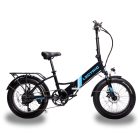

Comments